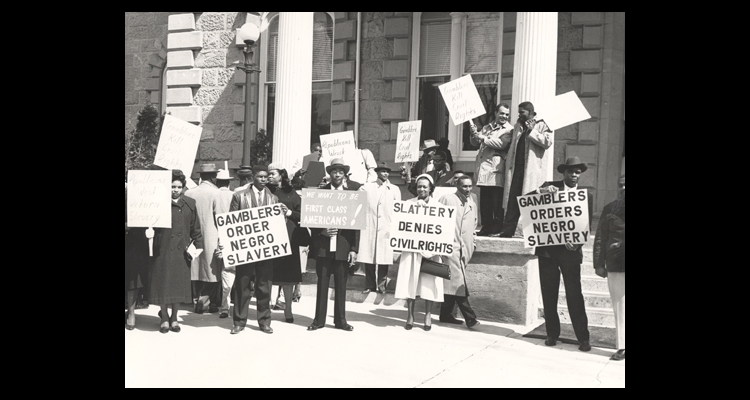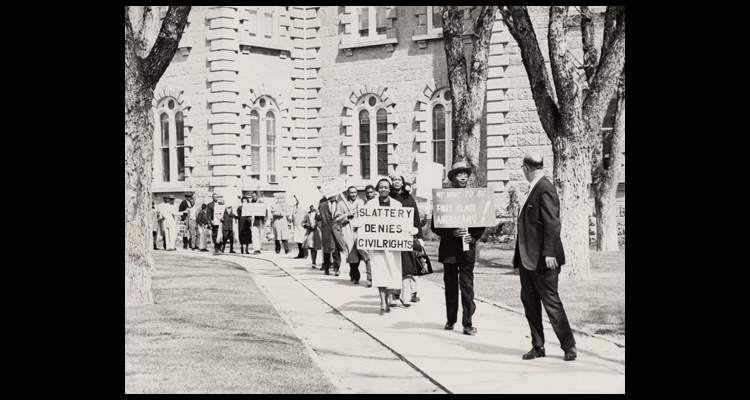School Segregation in Nineteenth-Century Nevada
One of the most contentious issues for authors of the Nevada State Constitution involved the education of racial minorities. In these debates, lawmakers grappled with the problem of a multi-racial population in a post-slavery society. Initially, they decided not to include minorities, principally African Americans and Chinese, in a universal compulsory education system. A Nevada Supreme Court decision in 1872, however, ended this exclusion and opened Nevada's public education system to racial minorities.
The issue of racially segregated education in Nevada first arose in the 1861 territorial legislature. That first legislature created a public school system similar to those in existence in California, but with one exception—Nevada did not explicitly forbid racially integrated schools. Although it is uncertain why this decision was made, it is reasonable to assume that it was a conscious choice due to the obvious familiarity of the lawmakers with the California system. Perhaps this is explained by the demographics of Nevada in 1861; of the 3,017 people living in the Comstock area in 1860, only seven were African American and only fourteen were Chinese. In addition, only five percent of the residents were female. Clearly, Nevadans saw no reason to fear a large minority presence—a presence that generated special fear when white women were involved—in these early classrooms.
The topic was much more contentious in the debates of the constitutional convention of 1863. The first education proposal put forth called for compulsory public education, but its approval was stalled over the issue of inclusion of non-whites. Delegates C. N. Noteware and James H. Ralston spearheaded an effort to specify that education was to be available and compulsory for white students only. The change was voted down at first, but the issue was resuscitated and approved the next day. Despite the wrangling, the compulsory education clause was eventually dropped altogether from the 1863 constitution, a point that became moot when the constitution was rejected by the voters. The 1864 constitutional convention briefly debated the subject on similar grounds, but ultimately decided to leave the matter out of the constitution itself.
Nevada's first legislature resolved this issue with legislation that excluded non-whites from Nevada's public educational system, and the 1867 legislature clarified the language: “Negroes, Mongolians, and Indians, shall not be admitted into the Public Schools, but the Board of Trustees may establish a separate school for their education, and use the Public School Funds for the support of the same.” This law was controversial from the beginning, and both African Americans and white Republicans criticized it.
While the opposition was gathering, various Nevada communities made efforts to provide education for non-whites. On the Comstock, at least two separate schools for non-white children were operated in the mid-1860s. A classroom located in the Oriental Hotel on E Street offered instruction for African American adults at night. In Carson City, the small African American community made an effort to fund and build a separate school for that city's African American children. In Elko, African American children were allowed to attend integrated schools as early as 1870. In Eureka, though, Thomas Detter claimed that no education at all was provided for non-white students.
The opposition to the inadequate public schooling for non-white students gathered strength in the late 1860s, especially after the ratification of the Fourteenth Amendment (1868) and Fifteenth Amendment (1870) to the U.S. Constitution. W. H. C. Stephenson, president of the Lincoln Union Club and unofficial spokesman for Virginia City's African American community, referred to the exclusion of African Americans from public schools as a “monstrous injustice,” especially in light of the fact that African Americans paid taxes to support them. To Stephenson, integration was not the primary issue—exclusion from education was the problem. In Stephenson's words, “To colored or separate schools, the people have raised no objection; but school privileges they claim as a matter of right and justice.” In reality, however, the high cost of separate facilities often resulted in the less expensive exclusion of non-white children from educational facilities.
In 1871, the constitutionality of Nevada's exclusion of minorities from public schooling was challenged in the courts. Nelson Stoutmeyer, an African American laborer in Carson City, Nevada, filed suit to get his son, David, admitted into Carson City's schools. In the resulting case, Stoutmeyer v. Duffy, the Nevada Supreme Court ruled that exclusion of Stoutmeyer from public schooling was unconstitutional, although it upheld the idea that separate educational facilities were constitutional. This was a moot point in Nevada, however, because separate educational facilities were not economically feasible.
Soon after the Stoutmeyer ruling, students of African descent were admitted to Nevada public schools. In 1873, the Nevada Legislature removed the separate school statute entirely and thus ended de jure segregated education in Nevada. De facto segregation—separate treatment due to places of residence and other factors—continued into the 1950s.
Article Locations
Related Articles
None at this time.

